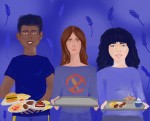When family weekend finally rolled around during my first quarter at UCLA, I was most excited to show off the amazing food on the Hill.
Then again, I hadn’t considered my dad, who has celiac disease, would be poisoned within the first five minutes of eating in a dining hall.
Celiac disease and gluten intolerance are conditions in which the body responds negatively to gluten, a protein found in wheat, barley and rye, with effects ranging from fatigue to malnutrition. While gluten-free diets have become more popular in recent years and awareness has increased, it doesn’t look like it for students on the Hill with celiac disease or gluten intolerance.
Many of UCLA Dining Services’ dishes contain gluten, and the few that don’t are often prepared in kitchens with gluten contaminants, making it difficult to avoid cross contamination. The dining halls provide allergen legends, which mark foods that contain wheat, but these labels do not cover the scope of different grains containing gluten. And while students can access the gluten-free pantries in De Neve dining hall and Bruin Plate, they must contact the Center for Accessible Education and fill out an extensive form to do so.
These students pay the same amount of money others do for a meal plan, but the university provides unequal levels of access to its high-quality cuisine. In doing so, students with gluten intolerance and celiac disease are cheated out of the UCLA dining experience and constantly risk exposure to contaminants in order to eat with their peers on the Hill. If the university claims to prioritize its students’ health and academic success, it must address this issue in order to ensure these priorities.
Students can’t be expected to function in UCLA’s rigorous academic setting if they are unable to easily access proper nutrition, and no student should have to fear getting sick from trying to enjoy the food here.
Madeline Utter, a first-year undeclared student, is diagnosed with celiac disease and said the lack of gluten-free options often affects her performance in school and her overall well-being.
“I go to a lot of classes hungry because a lot of people grab a bagel or a sandwich before class, but I can’t do that, so sometimes I just have a bar. Or sometimes I have nothing,” Utter said. “It definitely impacts you academically when you’re hungry all the time or you feel sick from eating gluten.”
Eating on the Hill is even harder for students with dietary restrictions and gluten intolerance. Sophia Donskoi, a first-year public affairs student who is gluten intolerant and vegan, often has to choose between eating food with a risk of gluten exposure and feeling sick, or going through the beginning of her day hungry – a ridiculous choice that a student should never have to make.
UCLA Dining Services said there are gluten-free pantries that contain toasters, microwaves and certified gluten-free dishes.
“Students who have medically diagnosed celiac disease or other medical conditions where their doctor has advised them to avoid gluten can get access to the gluten-free pantry to augment their food choices,” said Alison Hewitt, a UCLA spokesperson.
The process to gain access to the gluten-free pantry is painstaking, though. Utter said it took her two months to finalize the process over the summer, complete with multiple doctors visits in which she had her blood drawn.
Being able to easily access food that doesn’t make you sick should be the norm, but the process UCLA dining has set in place seems more like a trial.
According to a survey by Forbes, only 3 percent of 18- to 29-year-olds are vegan. Yet UCLA dining consistently offers vegan options, a diet that is not commonly followed for medical reasons. This highlights a stark discrepancy: UCLA does a fantastic job catering to a variety of diets, from vegetarian and vegan to kosher and halal, but students with a serious gluten sensitivity are forced to get their food from a separate, locked room if they want to ensure they won’t get sick.
Meal plans are by no means cheap, and if students with gluten intolerance and celiac disease are paying for food on the Hill, UCLA has a responsibility to provide them with the same high-quality food others get to enjoy.
Instead of providing locked gluten-free pantries, UCLA Dining Services should convert one station at every dining hall into a strictly gluten-free preparation area. Not only would it help students access food more conveniently without fear of cross contamination, but it would also ensure gluten-intolerant students don’t have go through CAE to eat food that won’t harm them.
The switch toward gluten-free options might seem a costly project. But, despite popular belief, gluten-free meals don’t all come from Whole Foods with a $20 price tag. In fact, most people eat gluten-free foods quite often without even being aware of it – meals don’t have to consist of gluten-free bread or other special accommodations, as long as they are filling and prepared in a kitchen without contaminants.
Unless the university can provide gluten-intolerant students with better alternatives, they shouldn’t be paying for a 14P meal plan to microwave their food in a locked room. Students aren’t lying their way into eating rice-based pasta.
And on the off chance they were, bringing gluten-free options to the menu would make it so they wouldn’t have to.

Reading this article raises a number of questions for me as a parent of a celiac. Safety and access are important issues but variety is certainly a very important issue as well. I’m not sure if the FARE guidelines address variety or not, but they seem like a good place to start. There’s a paucity of schools in California that appear on their list.